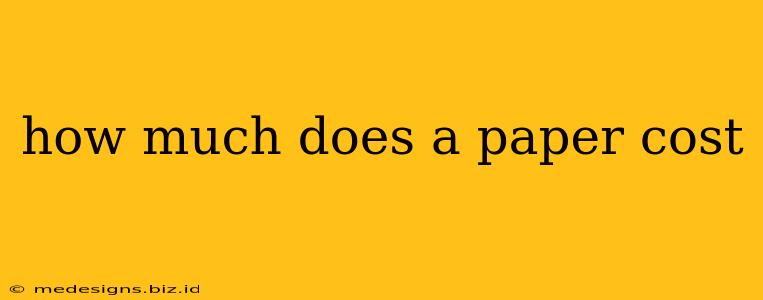How Much Does Paper Cost? A Comprehensive Guide to Paper Pricing
The cost of paper is surprisingly variable, depending on a multitude of factors. Understanding these factors is key to getting the best value for your money, whether you're buying reams for your home printer or tons for a large-scale printing project. This guide breaks down the pricing of paper, helping you navigate the complexities and make informed purchasing decisions.
Factors Affecting Paper Cost
Several key factors significantly influence the price you'll pay for paper:
-
Type of Paper: This is arguably the biggest factor. The sheer range of paper types is vast, each with its own cost implications:
- Printing Paper: Everyday paper for printers and copiers ranges from inexpensive standard weight (20lb) to heavier weights (24lb, 28lb) for more durable documents. The higher the weight, the higher the cost.
- Cardstock: Thicker and more rigid than printing paper, cardstock is used for business cards, postcards, and other projects requiring durability. Prices vary based on weight and finish.
- Specialty Papers: Papers with unique textures, finishes (like linen or embossed), or colors will command higher prices. Think handmade papers, recycled papers, or photo papers.
- Construction Paper: Commonly used in schools and crafts, construction paper is relatively inexpensive, especially in bulk.
-
Quantity: Buying in bulk almost always translates to lower per-unit costs. Larger orders usually receive discounts. This is especially true for larger printing projects needing pallets or reams of paper.
-
Weight: Paper weight, measured in pounds (lb) or grams per square meter (gsm), directly impacts the price. Heavier papers cost more because they use more raw materials.
-
Finish: The surface finish – matte, gloss, satin – affects the cost. Glossy finishes, for instance, often cost more due to the added processing.
-
Supplier: Different suppliers offer different pricing structures, so it pays to shop around and compare quotes. Online retailers often offer competitive prices, but consider shipping costs.
-
Location: Geographic location can influence pricing due to transportation, import taxes, and local market demand.
-
Recycled Content: Papers made with recycled content may or may not be more expensive depending on the supplier and the level of recycled content.
Estimating Paper Costs
While precise pricing requires contacting suppliers, you can get a general idea by looking at online retailers or office supply stores. Keep in mind these prices will vary based on the factors mentioned above. Expect to pay anywhere from a few dollars per ream for basic printing paper to significantly more for specialty papers.
Tips for Saving Money on Paper
- Buy in bulk: Purchasing larger quantities will almost always lower the per-unit cost.
- Consider recycled paper: This can be a more environmentally friendly and sometimes more cost-effective option.
- Shop around: Compare prices from various suppliers to find the best deal.
- Look for sales and discounts: Many retailers offer periodic sales on paper products.
- Opt for less expensive finishes: Matte finishes generally cost less than glossy finishes.
In conclusion, the price of paper is not a single number but rather a range determined by many interacting factors. By carefully considering these factors and utilizing smart shopping strategies, you can find the best value for your paper needs. Remember to always compare prices before committing to a purchase, especially for large-scale projects.
